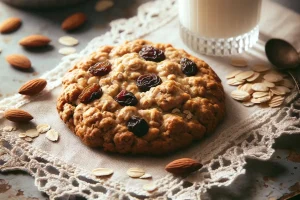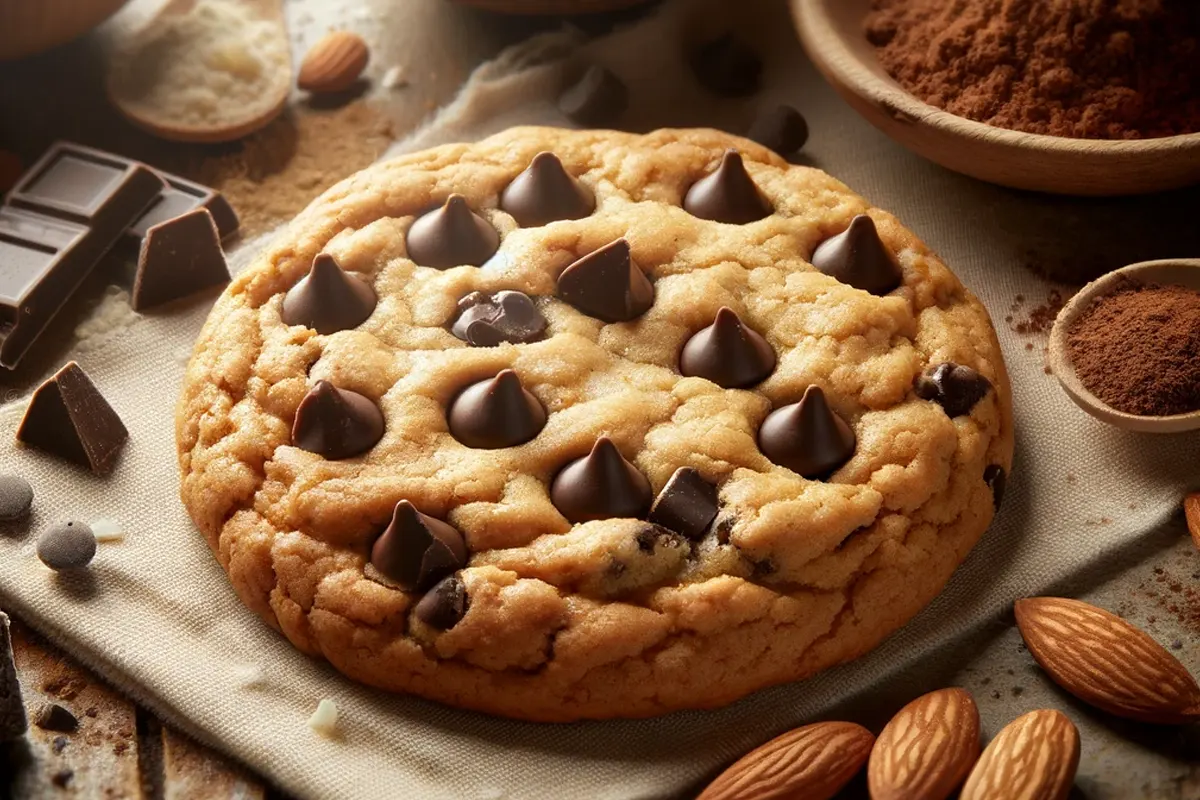In the whirlwind of dietary trends sweeping the globe, one delightful indulgence that’s been transformed for the better is the humble cookie. Gone are the days when gluten-free meant taste-free. Today, gluten-free cookies are not just a necessity for those with celiac disease or gluten sensitivities but a choice for many looking for healthier snack options. This comprehensive guide will take you on a delectable journey through the world of gluten-free cookies, much like our step-by-step guide to gluten-free sugar cookies, from understanding what makes a cookie gluten-free to mastering the art of baking them to perfection. So, whether you’re a seasoned baker or a curious newbie, prepare to be whisked away into a world where flavor and health go hand in hand.
Introduction to Gluten-Free Cookies
Understanding Gluten-Free Cookies
In the quest for the perfect bite, gluten-free cookies stand out as a beacon of hope for many. But what exactly makes a cookie gluten-free? At its core, it’s all about the flour. Traditional flours like wheat, barley, and rye are no-gos due to their high gluten content. Instead, bakers turn to alternatives like almond flour, coconut flour, and rice flour, which provide the foundation for our beloved treats without the gluten.
Yet, it’s not just about substituting flour; it’s a whole new baking paradigm. Gluten, notorious for giving dough its elasticity and cookies their chewiness, is conspicuously absent here. This absence necessitates creative culinary detours, employing binders like xanthan gum and flaxseed meal to mimic gluten’s structural roles.
The rising popularity of gluten-free baking isn’t just a fad. It’s a testament to the increasing awareness and sensitivity towards dietary needs and preferences. With celiac disease and gluten intolerance on the rise, the demand for gluten-free options has skyrocketed, making these cookies more than just a niche market. They’re a delicious declaration of inclusivity and awareness in the culinary world.
The Health Benefits of Going Gluten-Free
Opting for gluten-free cookies isn’t merely a dietary restriction, as detailed in our exploration of gluten-free cupcakes; it’s a lifestyle choice with potential health perks for everyone. For individuals battling celiac disease or gluten sensitivity, these cookies are a godsend, allowing them to enjoy without fear of adverse reactions.
But here’s the kicker: even those without gluten issues might find a friend in these cookies. Digestive comfort, reduced inflammation, and even a potential uptick in energy levels are just a few benefits that fans of gluten-free cookies rave about. However, it’s crucial to remember that gluten-free doesn’t automatically mean healthy. The key lies in choosing cookies made with wholesome ingredients and natural sweeteners, steering clear of the overly processed options.
Why, you might ask, are my gluten-free cookies falling apart? Ah, the million-dollar question in gluten-free baking! The culprit is often the lack of gluten, which, in traditional cookies, acts as the glue holding everything together. Fear not, for with a bit of baking magic—think xanthan gum or an extra egg—your cookies will be as sturdy as they are scrumptious.
In the grand tapestry of gluten-free baking, cookies hold a special place. They’re not just treats; they’re tiny, tasty symbols of how far we’ve come in accommodating diverse dietary needs. So, preheat your ovens and ready your spatulas, for the world of gluten-free cookies is rich with flavors just waiting to be explored.

Ingredients and Substitutes
Diving into the heart of gluten-free baking, similar to what we’ve done in our comprehensive guide to gluten-free cupcakes, the quest for the perfect gluten-free cookie is akin to an alchemist’s pursuit of gold. The transformation of basic ingredients into a batch of golden-brown delights hinges on the careful selection and combination of gluten-free elements that ensure taste and texture are not just preserved but enhanced. Let’s embark on this culinary adventure, exploring the treasure trove of ingredients and substitutes that make gluten-free cookies not just possible, but absolutely delectable.
Key Ingredients in Gluten-Free Cookies
At the core of any gluten-free cookie recipe lies the flour—or rather, flours. Gluten-free baking is an art that often requires a blend of different flours to replicate the texture and structure provided by their gluten-containing counterparts. Almond flour, with its nutty flavor, offers a rich, buttery texture, making it a favorite among gluten-free bakers. Coconut flour, another staple, is highly absorbent and lends a slight sweetness, perfect for softer cookie varieties.
But the magic doesn’t stop with nut and coconut flours. Brown rice flour brings a certain heartiness to cookies, while tapioca starch works wonders in creating a lighter, airier texture. The trick is in the mix—combining these flours in just the right proportions to achieve the desired consistency, from chewy and dense to light and crisp.
Sweeteners and Flavor Enhancers
What’s a cookie without its sweet allure? In gluten-free baking, the world of sweeteners is vast and varied. OG sugar and raw sugar are classic choices, but many bakers are turning to natural sweeteners like honey, maple syrup, and agave nectar for a healthier twist. These not only sweeten the deal but also contribute to the cookies’ moisture and texture.
Flavor, the soul of any cookie, comes from an array of sources. Vanilla extract remains a universal favorite, imparting a warm, aromatic essence that elevates the simplest of recipes. Spices such as cinnamon and cardamom, though used sparingly, can transform a basic batch into an exotic treat, inviting a sensory journey with each bite.
In gluten-free baking, every ingredient counts, playing a pivotal role in the final outcome. From the foundational flours to the subtlest of spices, the choices are deliberate, each contributing its unique character to the ensemble. It’s a symphony of flavors and textures, coming together in harmony to create something truly special. As we continue to explore the possibilities, remember that the essence of baking lies not just in the ingredients but in the joy of sharing these creations with loved ones. So, gather your substitutes, preheat your oven, and let the alchemy of gluten-free baking begin.
Recipes and Techniques
Diving deeper into the heart of gluten-free baking, we reach the creative and experimental sanctuary where recipes and techniques converge to craft the perfect gluten-free cookies. It’s a space where tradition meets innovation, and the results are nothing short of delectable.
Classic Gluten-Free Cookie Recipes
There’s something comforting about classic cookie recipes, but when they’re reimagined to be gluten-free, they offer a whole new level of enjoyment. The Ultimate Gluten-Free Chocolate Chip Cookie is a prime example. Imagine biting into a cookie that’s crisp on the edges, akin to the texture in our guide to baking and decorating sugar cookies, gooey in the middle, with melty chocolate chips in every bite – all without a speck of gluten. The secret? A blend of almond and coconut flours, combined with a touch of xanthan gum to bring the dough together, ensuring each cookie is as delightful as its gluten-containing counterpart.
Then there are the Oatmeal Cookies: A Healthy Twist. Using certified gluten-free oats mixed with a medley of spices and raisins, these cookies offer a chewy texture and a depth of flavor that’s hard to resist. They’re a testament to the versatility of gluten-free ingredients, proving that dietary restrictions don’t mean compromising on taste or texture.
Innovative Gluten-Free Cookie Variations
For those who revel in the unconventional, the realm of gluten-free cookies is a playground of possibilities. Consider incorporating superfoods like chia seeds or quinoa flakes into your cookies for an added nutritional boost. These ingredients not only enhance the health quotient but also introduce intriguing textures and flavors.
Seasonal and festive gluten-free cookie ideas abound, from Pumpkin Spice Cookies in the fall to Gingerbread Cookies during the holiday season. These recipes play with seasonal ingredients and spices to bring a sense of occasion to your cookie baking. Imagine the aroma of cinnamon, nutmeg, and ginger wafting through your kitchen as you bake a batch of gingerbread cookies, their festive shapes promising joy and warmth.
The art of baking gluten-free cookies lies in the willingness to experiment and the understanding of how alternative ingredients behave. It’s about embracing the quirks of gluten-free flours and celebrating the uniqueness they bring to each batch of cookies. With the right recipes and techniques, the world of gluten-free cookies is yours to explore, offering endless opportunities for delicious discoveries. So, why not don your apron, gather your ingredients, and let the magic unfold? After all, every cookie you bake is a step towards mastering the delightful craft of gluten-free baking.

Baking Tips and Storage
As we venture further into the delightful world of gluten-free cookies, mastering the baking process and understanding the best storage practices become crucial chapters in our culinary journey. After all, the magic doesn’t end when the cookies come out of the oven. How we handle and store them can make a significant difference in maintaining their irresistible texture and flavor.
Baking Tips for Perfect Gluten-Free Cookies
Achieving the right texture and consistency in gluten-free cookies can sometimes feel like a high-wire act. Without gluten to hold things together, it’s easy for cookies to become too crumbly or too dense. But, fear not! A few key tips can guide you to baking success:
- Precision is key: Gluten-free baking is more science than art. Measuring ingredients by weight rather than volume can lead to more consistent and reliable results. This accuracy ensures that the balance of wet to dry ingredients is just right, preventing those dreaded baking mishaps.
- Embrace the chill: Chilling your dough before baking can work wonders, especially with gluten-free recipes. It helps the fats solidify, preventing the cookies from spreading too much and resulting in a thicker, chewier cookie.
- Know your oven: Ovens can be fickle friends. Understanding how your oven distributes heat can help you adjust baking times and temperatures for optimal results. A simple oven thermometer can be a game-changer in ensuring your cookies are baked to perfection.
Common baking challenges, such as cookies spreading too thin or not rising properly, can often be mitigated with a few tweaks. For instance, if your cookies are spreading too much, consider reducing the amount of butter or increasing the chilling time. If they’re not rising, a bit more leavening agent, like baking soda or baking powder, might do the trick.
Storing and Preserving Gluten-Free Cookies
Once you’ve baked your batch of heavenly gluten-free cookies, ensuring they remain fresh is the next step. Here’s how to keep them tasting just-baked:
- Cool before storing: Let your cookies cool completely on a wire rack before storing them. This prevents condensation from forming in the storage container, which can make cookies soggy.
- Choose the right container: An airtight container is your best bet for keeping cookies fresh. For extra protection, you can place a piece of parchment paper between layers of cookies to prevent them from sticking together.
- Room temperature vs. freezer: Most gluten-free cookies will stay fresh at room temperature for several days. However, for long-term storage, freezing is the way to go. Just be sure to wrap them well and consider freezing them individually for easy thawing.
- Reviving cookies: If your cookies have lost their crisp, a few minutes in a warm oven can help bring back their original texture. Just be careful not to overbake them in the process.
With these baking tips and storage techniques in your arsenal, your gluten-free cookies are sure to be a hit, delighting your taste buds long after they’ve left the oven. So, go ahead, bake with confidence, and enjoy the fruits of your labor, one delicious cookie at a time.
Beyond Baking – Community and Culture
Venturing beyond the oven, the world of gluten-free baking is enriched not just by the cookies themselves but by the vibrant community and culture that surround them. This sense of belonging and shared experience elevates the act of baking from a solitary endeavor to a communal celebration.
The Community Aspect of Gluten-Free Baking
One of the most heartwarming aspects of gluten-free baking is the community, much like the one we’ve built around our gluten-free cupcakes is the sense of community it fosters. Online forums, social media groups, and local support groups are bustling hubs where gluten-free enthusiasts gather to exchange recipes, share success stories, and offer solace for the occasional baking flop. These platforms are a testament to the human spirit’s resilience, turning dietary restrictions into opportunities for creativity and connection.
For many, these communities serve as a beacon of hope and a source of invaluable information, especially for those newly diagnosed with celiac disease or gluten sensitivities. Within these supportive spaces, members not only learn about safe ingredients and cross-contamination but also about embracing a gluten-free lifestyle with positivity and grace.
Gluten-Free Baking Classes and Workshops
The communal spirit of gluten-free baking extends into the real world through classes and workshops that offer hands-on learning experiences. Led by expert bakers and chefs, these sessions are more than just instructional—they’re a celebration of the art and science of gluten-free baking.
Participants in these workshops discover the joys of baking with alternative flours, experimenting with natural sweeteners, and mastering the use of binders to replace gluten. But perhaps the most valuable takeaway is the sense of camaraderie that blossoms among attendees, united by a common goal to bake delicious, gluten-free treats.

The Impact of Gluten-Free Trends on the Food Industry
The rise of gluten-free baking has not gone unnoticed by the food industry. Once a niche market, gluten-free products now grace the shelves of supermarkets and health food stores, reflecting the growing demand for these options. From pre-mixed flours to ready-to-eat cookies, the variety is staggering, making gluten-free living more accessible than ever.
Moreover, the influence of gluten-free baking has inspired chefs and restaurateurs to innovate, incorporating gluten-free options into their menus. This culinary evolution not only caters to those with dietary restrictions but also introduces a wider audience to the delights of gluten-free cuisine.
The journey through the world of gluten-free cookies reveals much more than recipes and baking tips. It uncovers a thriving culture and a community bound by the shared experience of navigating dietary challenges with creativity and joy. As we continue to explore and celebrate gluten-free baking, we’re reminded of the profound ways food can connect us, teaching us to savor not just the flavors on our plates but the stories and friendships that come with them.
Frequently Asked Questions About Gluten-Free Cookies
Can gluten-free cookies taste as good as regular cookies?
Absolutely! With the right blend of gluten-free flours and a touch of culinary creativity, gluten-free cookies can rival (and sometimes even surpass) the taste and texture of traditional cookies. The key is in understanding the properties of gluten-free ingredients and how they interact. Ingredients like almond flour and coconut flour not only substitute for gluten-containing flours but also introduce rich, nuanced flavors that enhance the overall taste of the cookies.
Are gluten-free cookies healthier than regular cookies?
The healthfulness of gluten-free cookies largely depends on the ingredients used. While the absence of gluten makes them suitable for those with celiac disease or gluten sensitivities, it’s the choice of whole, unprocessed ingredients that truly defines their nutritional value. Opting for natural sweeteners, healthy fats, and nutrient-dense flours can elevate the health quotient of your gluten-free cookies. However, it’s important to enjoy them as part of a balanced diet.
How can I ensure my gluten-free cookies don’t crumble?
Ah, the classic conundrum of gluten-free baking! The lack of gluten, which acts as a natural binder in traditional baking, can lead to crumbly textures. To combat this, you can incorporate binders such as xanthan gum, guar gum, or even psyllium husk into your recipes. These ingredients mimic the structural properties of gluten, helping to hold your cookies together and deliver that satisfying bite.
Where can I find gluten-free cookie recipes?
The internet is a treasure trove of gluten-free cookie recipes, ranging from classic chocolate chip to inventive new flavors. Start with reputable cooking blogs, gluten-free community forums, and websites dedicated to gluten-free living. Celiac Disease Foundation offers a wealth of resources, including recipes that cater to various dietary needs. Remember, gluten-free baking is as much about exploration as it is about following recipes, so feel free to experiment and make each recipe your own.
Navigating the world of gluten-free baking can be as challenging as it is rewarding. But with each question asked and answered, you’re not only honing your baking skills but also joining a community of bakers who share your quest for the perfect gluten-free cookie. So preheat your oven, gather your ingredients, and embrace the journey, cookie by cookie.

